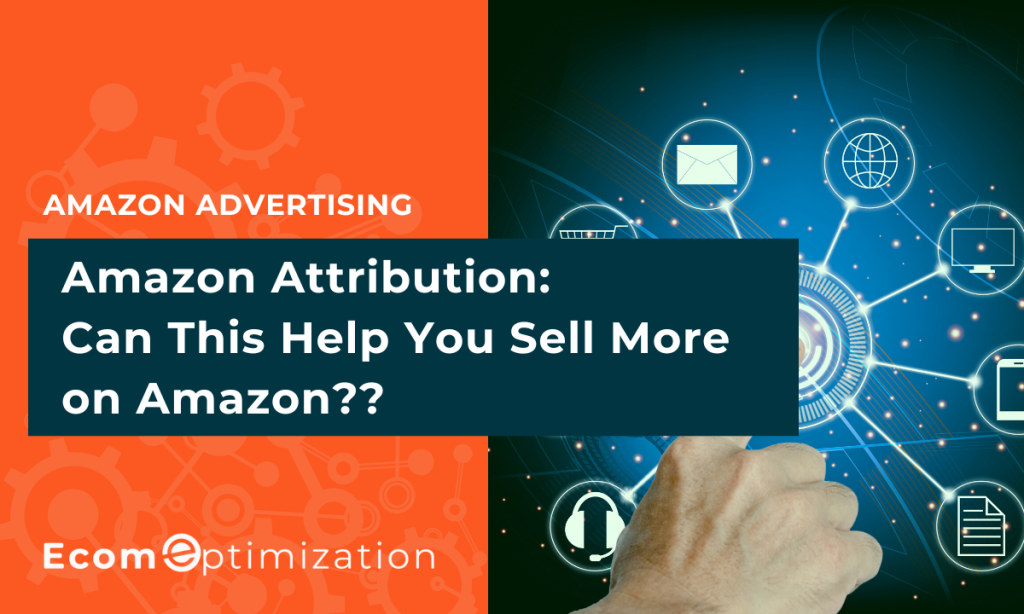Amazon Attribution: Can This New Tool Help You Sell More on Amazon?

Amazon ads are more powerful than ever, and Amazon Attribution is now offering brands new ways to integrate off-Amazon ads such as Google, Facebook, and TikTok, and measure their effectiveness as a central part of a full-funnel marketing strategy.
The question is, Should you use it?
In this post, we’ll explore what Amazon attribution is, the benefits of Amazon Attribution reporting, how it works, and whether you should use it to optimize your marketing strategies.
Table of Contents
What is Amazon attribution reporting?

Amazon Attribution reporting is a tool that tracks the effectiveness of off-Amazon marketing campaigns. It works by assigning a unique Amazon attribution tag so you can track the performance of your campaigns across various channels such as social media, display ads, and email marketing. By analyzing this data, you gain insights into which channels are most effective at driving traffic to your Amazon product pages and stores.
These insights are intended to help you build more effective marketing strategies and campaigns, and understand which channels are driving results on Amazon.
Businesses can access their metrics via a reporting dashboard.
What are the main use cases of Amazon attribution?
The MidWest Homes For Pets story

Dedicated to building safe, healthy, and comfortable pet environments, MidWest Homes for Pets offers a complete line of dog crates, small animal modular habitat systems, and birdcages, in addition to other pet enclosure systems, bedding, and related accessories. Since originally launching its pet supply line on Amazon, the company has come to view Amazon as one of its key sales and marketing channels.
Situation
MidWest Homes for Pets has been trying to grow their business on Amazon over the past three years. They have been utilizing Store Insights to assess sales velocity and the effectiveness of their non-Amazon ad campaigns. However, they wanted more details about which tactics were leading to sales on their product line.
Solution
MidWest Homes for Pets wanted to gain more insights into their off Amazon marketing efforts, so the Amazon Attribution was deployed for the brand. The Amazon Attribution tag was placed across their main marketing platforms, and from the measurement console, they could monitor how their brand was making an impact on Amazon shoppers.
Learn more about the Attribution console: https://advertising.amazon.com/solutions/products/amazon-attribution?ref_=a20m_us_lbr_cs_mwh4p_attr&isSSO=true
MidWest Homes for Pets were able to gain a unified view of their performance by combining Amazon metrics—such as sales, page views, and “Add to Carts” by channel—with the clicks, ad spend, and cost per click of their non-Amazon channels. Adding an attribution tag to each ad group within their publisher campaigns also allowed them to understand performance at the category level. With this single view, they could measure the cost efficiency of their non-Amazon marketing channels and optimize their publisher strategies. The result was increased sales on Amazon with a higher return on ad spend (ROAS).
How does Amazon Attribution reporting work?

Amazon Attribution reporting works by assigning a unique attribution tag to each of your non-Amazon ad campaigns. This tag is placed on the landing page of your campaign, which allows Amazon to track the performance of your campaign. You can then access your metrics in reports or a multi-dimensional reporting dashboard, which provides a comprehensive view of your campaign performance.
Here are some of the benefits of using Amazon Attribution:
Measure the impact of non-Amazon campaigns on Amazon sales: With Amazon Attribution, advertisers can track how their off-Amazon campaigns are influencing sales on Amazon. This helps advertisers understand which campaigns are most effective in driving sales and which channels are worth investing in.
Optimize marketing efforts: With the data from Amazon Attribution, advertisers can optimize their marketing campaigns and improve their return on investment (ROI). For example, if a certain campaign is not driving sales on Amazon, the advertiser can adjust their messaging or targeting to improve its performance.
Gain insight into customer behavior: Amazon Attribution provides valuable data on customer behavior, such as which products customers are clicking on and purchasing after interacting with non-Amazon campaigns. This can help advertisers tailor their messaging and product offerings to better meet customer needs.
How do I enable Amazon attribution?
Enabling Amazon Attribution is a straightforward process. Here are the steps to get you started quickly:
Step 1: Start your campaign and choose a creation method

To set up Amazon Attribution, log in to your Amazon account and go to the Campaign Manager tab from the left side.
From there, go to Measurement and Reporting, and you will see Amazon Attribution. Click on it to set it up.
To create a campaign, click on the Create Campaign button, and you will see the option to do it manually or in bulk.

For to get you set up quickly we will select the choice to Create manually under the section titled “Creation Method”.
Step 2: Select the options for your campaign and products for sale on Amazon.
In the campaign manager, give your campaign a name that is specific to the type of products you are advertising or your goal for the campaign, such as boosting your top products, launching a new item, offering seasonal discounts, or raising brand awareness on Amazon. To be eligible for tracking, the products should need pictures and prices. Select items that match your campaign’s goals from the list of all the products you are currently selling on Amazon.
Note: Amazon Attribution offers the ability to segment advertising campaigns according to product grouping. This includes the incorporation of multiple products into a single advertising campaign, to help determine which products shoppers purchase after clicking an ad linked via non-Amazon marketing channels. To ensure that all of the right products are included in the data, brands can manage their brand-to-product mapping in the “Access and Settings” section. Here, changes can be requested so that the effectiveness of ad campaigns can be accurately measured.
Step 3: Create ad groups and generate attribution tags
Create individual ad groups for each strategy, tactic, or creative you use. For instance, make a group to track the effect of an organic social media post, and another one to analyze the effectiveness of a paid advertisement. Amazon Attribution will generate a unique attribution tag for each group. This allows you to measure the sales made with the selected products.
Then add the following:
Ad group name: Come up with a name for the advertising group based on where and how the attribution tag will be used.

Publisher: Choose the publication that relates to your advertisement or post. If it is not listed, pick “New” and type in the name of the publisher.

Channel: Select the platform which is associated with the promotion that you are measuring.

Click-through URL: Choose the Amazon page you would like your ad to direct customers to. If you want to increase sales for a particular item, include a link to the Product page. If you want to generate interest in several items, consider linking to your store, so shoppers can explore your brand.

Step 4: Apply your attribution tags
Once you’ve set up your campaign, you can use the attribution tag URL to run your ads on the selected publisher, such as Google or Facebook. This way, you can track clicks and conversions and see which ads are driving traffic and sales to your products.
Simply add the attribution tags to campaigns on other channels or on social media ad managers.

How can I use Amazon Attribution reporting to optimize my campaigns?
Amazon Attribution reporting provides valuable insights that can help you optimize your campaigns in a number of ways.
By analyzing your metrics, you can gain insights into which channels are most effective at driving traffic to your Amazon product pages and stores.
By identifying which campaigns may need to be optimized
By giving insight into adjustments to your targeting, creative, or messaging.
Additionally, by leveraging insights from detailed product reports, you can maximize customer engagement by promoting deals or new products.
What is Amazon attribution code (aka, “the tag”)?
Amazon Attribution enables individuals to generate a URL that links to their product listing and can be tracked by Amazon. This link can be included in an advertisement, blog, email, or other mediums, similar to a regular link that directs people to their listing.
What is Amazon attribution 14 days?
Amazon Attribution employs a 14-day last-touch attribution system. To receive credit for a conversion, it must take place within 14 days after the click. The most recent click will be credited with the conversion.
What is an attributed sale on Amazon?
When a shopper clicks on an ad on Amazon and then buys one of your brand’s products, it is counted as an attributed sale. For first-party sellers, only sales of their brand registered products when Amazon is the seller will be counted as Sponsored Products attributed sales, not sales from third-party merchants.
How long does Amazon attribution take?
Amazon Attribution uses a 14-day, last-touch attribution system. This implies that for a click to be credited for a sale, the purchase must take place within 14 days of the click. The most recent click will get the credit for the sale.
How do I use Amazon attribution with Google Ads?
By using Amazon Attribution URLs in your Google Advertising campaigns, you can gain a better understanding of how your advertising efforts are contributing to your overall sales.
How do I set up Google AdWords campaigns with Amazon Attribution URLs?
To set up a Google Ad campaign with an Amazon Attribution URL, follow the normal steps to set up a Google Ad Campaign, with the addition of the tracking URL:
Log into your Google Ads account and click “create a campaign.”
Choose any sales objective and campaign types you wish (e.g., search).
Add your Amazon Attribution link.
Set up bidding and select networks.
Add keywords, display path headline, and description.
Monitor data from inside your Amazon Attribution dashboard
What is click-through attribution vs view-through attribution?
Click-through attribution describes how shoppers click on an ad and then make a purchase, while view-through attribution (VTA) shows how someone viewed an ad.
Why is view-through attribution important?
The purpose of view-through attribution is to allow advertisers to better understand which ads and channels are driving sales and downloads external marketing campaigns. Without View Through of attribution, marketers may make incorrect assumptions about how successful certain campaigns are in terms of generating conversions.
Why you should drive external traffic to your Amazon listings
As an Amazon seller, you know the importance of driving traffic to your store. One way to do this is by leveraging external traffic sources such as social media, search engines, and affiliate marketing. Let’s look at some tips and best practices for driving external traffic to your Amazon store.
Tip #1: Optimize your Amazon Store and Products Before driving external traffic. Make sure your store and pages are ready to sell. This means optimizing your product titles, descriptions, and images are top-notch and have real emotional pull. By doing this, you’ll increase the chances of converting the traffic you drive to your store.
Tip #2: Leverage Social Media Social media platforms. Use your presence and advertising efforts on platforms like Facebook, Instagram, Tik Tok, and Twitter to generate traffic for your Amazon store. This can be in the form organic traffic and ads focused around product promotions, discounts, and giveaways.
Tip #3: Use Google Ads. Another way to drive external traffic to your Amazon store is by using Google Ads. Google Ads allow you to target users who are actively searching for products related to your niche. By placing ads that direct users to your Amazon store, you’ll increase the chances of converting these users into customers.
Can Amazon Attribution Help You Sell More on Amazon?
If you are intentionally driving traffic to your on-Amazon properties (brand stores and product pages) Amazon Attribution can be a powerful tool to drive traffic and help you build a stronger presence on Amazon by:
Tracking the effectiveness of your ads and campaigns with detailed analytics.
Making informed decisions about which products to promote
Understanding how to optimize ad spend for maximum visibility
Identifying opportunities for growth.
If this type of data measurement is useful to your brand, then yes, Amazon Attribution can help you grow sales on Amazon.
FAQ:
Q: Do I need an Amazon Advertising account to use Amazon Attribution?
A: Yes, you need an Amazon Advertising account to use Amazon Attribution.
Q: How long does it take to set up Amazon Attribution?
A: Setting up Amazon Attribution can take anywhere from a few minutes to a few hours, depending on the complexity of your non-Amazon campaigns.
Q: How do I get started with Amazon Attribution reporting?
A: To get started with Amazon Attribution reporting, you will need to have an Amazon Professional Seller account. You can then access Amazon Attribution reporting in the advertising console, under the reporting and measurement menu. Visit Amazon Advertising to find out more: https://advertising.amazon.com/library/guides/basics-of-amazon-attribution?isSSO=true
Q: What types of metrics are available in Amazon Attribution reporting?
A: Amazon Attribution reporting provides a range of metrics, including detail page views, add-to-carts, and purchases. You can also access detailed product reports that provide insights into how customers discover and engage with your products.
Q: Can I use Amazon Attribution reporting for all of my marketing campaigns?
A: Amazon Attribution reporting can be used for most types of marketing campaigns, including social media, display ads, and email marketing. However, it is important to note that Amazon Attribution reporting is only available for Professional Amazon sellers and vendors.
Q: Can Amazon Attribution help me avoid overspending?
A: Yes, Amazon Attribution can help you avoid overspending by providing insights into which activities are profitable and which are not. By optimizing your campaigns based on the data provided by Amazon Attribution, you can avoid overspending and grow your Amazon business more efficiently.
Q: What results can I expect from using Amazon Attribution URLs in my Google AdWords campaigns?
By using Amazon Attribution URLs in your Google AdWords campaigns, you can expect to see increased traffic and sales from outside Amazon. Additionally, you’ll gain insights into the effectiveness of your advertising efforts and can use this data to optimize your campaigns for better results.
Q: Do I need an Amazon marketing agency to take advantage of Amazon Attribution?
A: While it’s not necessary to hire an agency, it can be beneficial if you don’t have the time or resources to implement and monitor Amazon Attribution strategies on your own. An full-service Amazon account management agency can certainly help and take away many of the other headaches that happen when dealing with Amazon.















